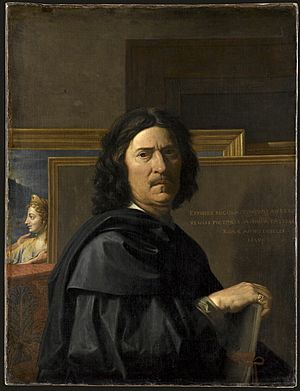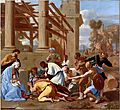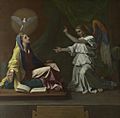Nicolas Poussin facts for kids
Quick facts for kids
Nicolas Poussin
|
|
|---|---|

Self portrait by Nicolas Poussin, 1650
|
|
| Born | June 1594 |
| Died | 19 November 1665 (aged 71) |
| Nationality | French |
| Known for | Painting |
|
Notable work
|
Et in Arcadia ego, 1637–38 |
| Movement | Classicism Baroque |
Nicolas Poussin (born June 1594 – died November 19, 1665) was a very important painter from France. He was known for his classical style, which was part of the French Baroque art movement. Even though he was French, he spent most of his life working in Rome, Italy.
Poussin mostly painted scenes from religious stories and old myths. He created these for a small group of art collectors in Italy and France. His paintings are known for being clear, logical, and orderly. He focused more on drawing lines and shapes than on bright colors. Many famous artists, even up to the 20th century, were inspired by his work.
Contents
Early Life and Art Training
Nicolas Poussin was born near a town called Les Andelys in Normandy, France. We don't know much about how he learned to paint. One of his early friends and biographers, André Félibien, said that young Poussin was always drawing. He filled many sketchbooks with different figures from his imagination.
His early drawings caught the eye of Quentin Varin, an artist who visited Andelys. Poussin's later paintings showed some of Varin's influence, especially in how they told stories and showed feelings. Poussin's parents didn't want him to be a painter. So, around 1612, when he was about 18, he ran away to Paris.
Becoming a Professional Artist
Poussin arrived in Paris when art was very popular. The queen, Marie de Medici, was ordering many artworks for her palace. Rich merchants in Paris were also buying a lot of art. Churches outside Paris, which had been damaged in wars, also needed new paintings.
However, Poussin was not part of the main group of master painters. This group had control over most art jobs and made it hard for new artists like Poussin to get work.
Learning in Paris Studios
Poussin's early drawings helped him get into the studios of other painters. He worked for three months with Ferdinand Elle, a painter from Flanders. Elle mostly painted portraits, which Poussin wasn't very interested in. After that, he might have studied for a month with Georges Lallemand. But Poussin didn't like Lallemand's style, which wasn't very precise.
Poussin also didn't like working in a studio where many painters worked on the same painting. He preferred to work slowly and by himself. We don't know much about his life in Paris at this time, but records show he had many debts. He studied anatomy and how to draw things in perspective.
The most important thing that happened in Paris was his discovery of the royal art collections. A friend helped him see these. There, he saw drawings by Giulio Romano and especially Raphael. Raphael's art had a huge impact on Poussin's future painting style.
First Attempts to Reach Rome
Poussin first tried to travel to Rome around 1617 or 1618. But he only made it to Florence before returning to France. When he came back, he started painting for churches and convents in Paris.
In 1622, he tried again to go to Rome. This time, he only reached Lyon before turning back. In the summer of that same year, he got his first big job. The Jesuits asked him to paint six large pictures to honor their founder, Saint Francis Xavier. These paintings (which are now lost) were very original and energetic. They helped him get more important jobs.
Moving to Rome
A court poet named Giambattista Marino hired Poussin to make 15 drawings. Eleven of these showed scenes from Ovid's Metamorphoses, an ancient poem. The other four showed battle scenes from Roman history. These "Marino drawings" are now at Windsor Castle.
Marino's influence also led to Poussin getting a job to decorate the Luxembourg Palace. Then, the first Archbishop of Paris asked him to paint a picture of the death of the Virgin for a chapel at Notre-Dame de Paris. Marino took Poussin into his home. When Marino returned to Rome in 1623, he invited Poussin to join him. Poussin stayed in Paris to finish his jobs, then arrived in Rome in the spring of 1624.
In Rome, Poussin studied the works of Renaissance and Baroque painters, especially Raphael. He became friends with other artists who liked the classical style. He also met important people who supported artists, like Cardinal Francesco Barberini. Poussin received jobs to paint smaller pictures about religious, mythological, and historical topics. This helped him develop his unique style. Examples include The Death of Germanicus and The Massacre of the Innocents. He also painted his first series of Seven Sacraments.
Return to France and Final Years
Poussin was asked to return to France in 1640 to be the King's First Painter. But he didn't like the huge amount of work and the arguments at court. So, after a little over a year, he went back to Rome for good.
In Rome, Poussin lived a simple and comfortable life. He worked slowly and seemed to paint without any helpers. After 1650, his health started to get worse. His hand began to shake, which you can see in his later drawings. Even so, in his last eight years, he painted some of his most famous works. These include The Birth of Bacchus, Orion Blinded Searching for the Sun, and the four paintings of The Seasons.
His wife, Anne-Marie, died in 1664. After that, Poussin's own health quickly declined. He died in Rome on November 19, 1665, and was buried in the church of San Lorenzo in Lucina.
What Poussin Painted About
Every painting by Poussin told a story. Even though he didn't have much formal education, Poussin knew a lot about religious history, myths, and old literature. He usually talked with his clients and chose his subjects from these topics. Many of his paintings combined different events that happened at different times to tell a full story. The faces of the people in his paintings, called affetti, showed their different feelings. Poussin never painted about modern-day events, except for his self-portraits.
Poussin's Landscapes
Poussin was very important in the history of landscape painting. In his early works, the landscape was often a nice background for a group of people. But later, the landscape became more and more important. It often showed sad stories from the Bible, myths, or old history.
His landscapes were very carefully planned. Tall trees and classical columns were balanced by calm water and flat stones. Everything was arranged to guide your eye to the often tiny people in the scene. The leaves on his trees and bushes were painted with great detail.
His skies were also very important. He painted blue skies with gray clouds and bright sunlight (often called "a Poussin sky" in France) for peaceful scenes. An example is Landscape with Saint John on Patmos. For sad events, he painted very dark, stormy, and threatening skies, like in his Landscape with Pyramus and Thisbe (1651). Many of his landscapes have hidden details that you only notice if you look closely. For example, in the middle of Landscape with Pyramus and Thisbe, the lake is perfectly calm, even though there's a storm in the sky.
Between 1650 and 1655, Poussin also painted "townscapes." In these, classical buildings replaced trees and mountains in the background. The painting The Death of Saphire uses this setting to tell two stories at once. In the front, a rich merchant's wife dies after being told off by St. Peter for not giving enough money to the poor. In the background, another man, who is more generous, gives money to a beggar.
How Poussin Painted
Throughout his life, Poussin was different from other French artists who liked very decorative art. Poussin's work kept the ideas of the Renaissance alive. He also looked to the art of classical antiquity (ancient Greece and Rome) as the best example. He didn't like the strong emotions shown by Baroque artists like Bernini. Instead, he focused on ideas and clear thinking. His goal was to make his paintings clear by using disegno (good design and drawing) rather than colore (color).
In the late 1620s and 1630s, he tried out different ways of painting and created his own style. He studied ancient art and also works by artists like Titian.
Compared to his early paintings, which were warm and atmospheric, Poussin's style by the 1630s used cooler colors. His brushstrokes were drier, and he arranged figures in a clear, stage-like space.
Unlike most artists of his time, Poussin did not make detailed drawings of figures before painting. He also seemed to paint all by himself, without helpers.
Poussin's Lasting Impact
After Poussin died, his style had a big influence on French art. This was partly thanks to Charles Le Brun, who had studied with Poussin in Rome. Le Brun also became a court painter for the King and later led the French Academy in Rome. Poussin's work also influenced other painters in the 17th century, including Jacques Stella, Sébastien Bourdon, and Gerard de Lairesse.
Today, the best collection of Poussin's paintings is at the Louvre museum in Paris. Other important collections can be found in the National Gallery in London, the National Gallery of Scotland, the Dulwich Picture Gallery, the Musée Condé, the Hermitage Museum in Russia, and the Museo del Prado in Spain.
Related pages
Images for kids
-
Blind Orion Searching for the Rising Sun, 1658, The Metropolitan Museum of Art
-
Et in Arcadia ego (The Shepherds of Arcadia), second version, late 1630s, Louvre
-
A Dance to the Music of Time, 1640, Wallace Collection, London
-
Landscape with Saint John on Patmos, late 1630s, Art Institute of Chicago
-
Landscape with the Ashes of Phocion, 1648, Walker Art Gallery
-
The Four Seasons (Spring), c. 1664, The Louvre
-
The Adoration of the Magi, 1633, Dulwich Picture Gallery, London
-
The Abduction of the Sabine Women, c. 1633–1634, The Metropolitan Museum of Art
-
The Adoration of the Golden Calf, 1633–1634, National Gallery, London
-
The Crossing of the Red Sea, 1633–1634, National Gallery of Victoria
-
Sacrament of Ordination (Christ Presenting the Keys to Saint Peter) , c. 1636–1640, Kimbell Art Museum
-
Holy Family, c. 1649, National Gallery of Ireland
-
Discovery of Achilles on Skyros, c. 1649–1650, Museum of Fine Arts, Boston
-
Landscape with a Calm, 1650–1651, Getty Center
-
The Annunciation, c. 1655–1657, National Gallery, London
See also
 In Spanish: Nicolas Poussin para niños
In Spanish: Nicolas Poussin para niños






















